by Dan La Botz
July 2, 2012
This document was prepared at the request of the Solidarity Political Committee for an examination of “the nature of the period” and the balance of forces in American society today. In response to those suggestions, I have written this brief document. This paper looks principally at the economic and political situation and the state of labor unions, some of the social movements, and the left. We are aware that we have omitted many other developments taking place in society at large, for example in the area of civil liberties. I have included links throughout the piece to articles I have written on the crisis and the state of the labor movement over the last four years, which I think represent a consistent analysis and in very broad terms a proposal for a socialist response. [Also see the Solidarity Political Committee’s “Brief Sketch of the Politics of Austerity.”]
Introduction
We are living in a period of economic crisis which both poses great challenges and offers significant opportunities to socialist organizers in the working class and in the social movements. The impact of the crisis on the world political situation over the last four years has been dramatic, contributing to the Arab Spring and the Southern European strikes and social protests, the fall of several European governments, and a growing polarization in European politics. In China the combination of capitalism rampant, punctuated by economic crisis, has led to over 100,000 social protests a year, many of them mass protests against corporate or government land seizures, but also including 30,000 strikes at various state and private enterprises. By and large, around the world, the working class has not had the organizational capacity or the political independence to respond effectively to the crisis, while the left has been too small and divided to have an effective impact (See: “The Global Crisis and World Labor Movement”).
In the United States the protracted character of the crisis and its depth, combined with a conservative political attack on labor unions have weakened the workers movement. At the same time, the crisis in America has also led to some union and popular resistance, such as the Wisconsin events of a year ago, and to upheavals such as Occupy. The character of the crisis and the issues facing the working class and society at large will require socialists to develop a sharper analysis of events, more cohesive and stronger organizations, and astute strategies for intervening in the movement. Our task is to present our ideas in a popular fashion and to work as activists in the movement to cohere a left response which can develop the key strategic ideas for a working class response.
The American working class remains largely unorganized, with only a small percentage of workers who are organized, and those primarily in business unions. Workers by and large have little experience of strikes, and remain under the control of a bureaucratic caste of high-level union officials who have neither the desire nor the ability to lead a resistance movement. The union leadership continues to pursue a policy of “partnership” with the corporations and collaboration with employers and continues to rely upon the Democratic Party, rather than to organize an independent and militant movement to fight back against the employers and the politicians. The current situation, of course, is the result of a thirty-year long employer and political offensive against the unions that may be said to have begun with PATCO in 1981.
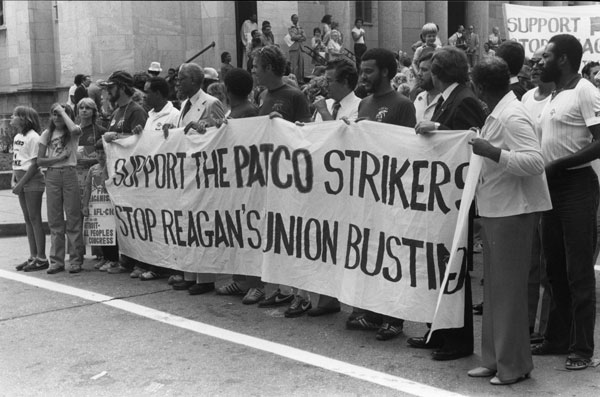
The American left does not at this moment have the weight to have a significant impact on the labor movement or the social movements generally. As I wrote in May of 2008, unlike the left at the time of the 1930s crisis, we are in an extremely weak position, without the organization and the strategies that we need to be able to intervene effectively. Solidarity and other socialists in the movement need to find ways to build the resistance movements, especially the resistance of rank-and-file workers in the unions, unorganized workers, as well as that of working class and poor communities and among all of those who suffer discrimination and oppression in our society. At the same time, we need to raise socialist ideas propagandistically, to build our periphery and to recruit.
The Nature of the Period
The world economy remains mired in a protracted recession that has now lasted four years, with national governments and the international financial institutions still scrambling to prevent bank failures which might cause a complete collapse of the international financial system. While at this moment the center of the crisis is in Europe, particularly in Greece, Spain and Italy, the weaknesses of banks in those countries poses the possibility crisis for France, Germany and all of Europe. Many economic analysts of various political opinions foresee the European crisis detonating another recession in the near future.
We certainly have no reason at this time to believe that economic recovery will take place soon; on the contrary, the conservative (tax and budget cutting) programs are deepening the immediate crisis, and while Keyenesian (stimulus) measures might help in the short run, they will not solve the system’s underlying, long term issues of declining profitability. A genuine depression that wiped out less financial institutions and plants could bring about the basis for a classic capitalist recovery — but at the expense of particular capitalist corporations and investors who, of course, do all in their power to protect themselves.
For working people, the primary effect of the crisis is the rise in unemployment. The economic crisis has led to massive unemployment throughout the world with few exceptions. The International Labor Organization (ILO) puts the number of unemployed at 50 million, though that may be a low figure. The jobless rate in the European Union has increased to its highest level in 15 years, at 10.9 percent in May.
The Economic Crisis in the U.S.
In the United States, the unemployment rate is back up to 8.2 percent, with unemployment having increased in 18 states in May. At present in the U.S. 5.8 million people receive unemployment benefits, but millions of others who are unemployed are not collecting benefits at all. U.S. government unemployment statistics do not include those who have become discouraged workers and cease to look for work or those with temporary or part time jobs who want full-time work. Some experts believe that including those workers would double the unemployment rate. The civilian labor participation rate, that is, the number of those who might be working who have jobs, is down to 63.6 percent the lowest since the 1930s.
While the crisis in the United States initially affected the financial sector, construction, and then manufacturing, today, as a result of the conservative drive to cut taxes and the budget, we find that over 700,000 public employees have also lost their jobs. At the same time, those with jobs find that take home pay and personal income have fallen to the lowest point in 17 years. Loss of jobs and low wages have made it difficult for millions of Americans to hold on to their homes. Since the start of the financial crisis in September 2008, there have been approximately 3.6 million completed foreclosures, that is, homes lost, in the United States.
Structural Racism in the Crisis
The structural racism of our society means that the crisis falls harder on people of color. African Americans today, as in the past, have suffered an unemployment rate about twice that of white Americans, averaging about 16 percent throughout the crisis. Again, if we included discouraged workers and those who have accepted temporary and part-time jobs though they need full-time jobs, that would double the figure to about 30 percent. In some locations, African American unemployment is at shocking levels, such as New York City where it is 50 percent, comparable to black unemployment in urban areas during the Great Depression of the 1930s.
Latino unemployment is reported at 11 percent, but because many Latino immigrants are undocumented and may not be counted, the figure may be higher. If we also included the undocumented and again double the figure because of discouraged workers, temporary and part-time job holders, the figure might also be 30 percent. Hundreds of thousands of Mexicans unable to find work and fearing deportation appear to have returned to Mexico.
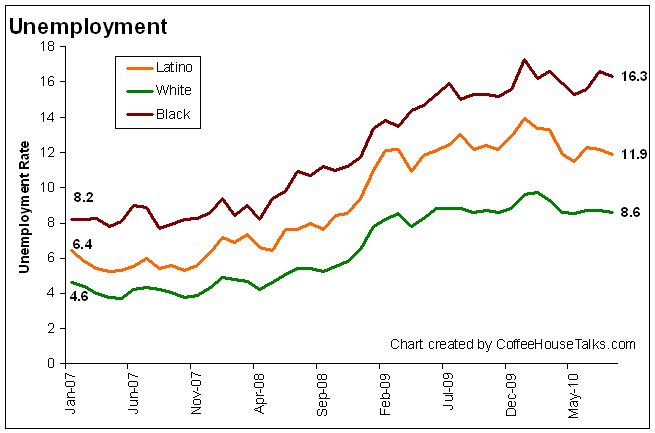
Labor union membership remains at 11.9 percent or 14.8 million workers. Only 6.9 percent of private sector workers have labor unions, while 37.0 percent of public sector workers are organized (BLS data here). There have been a few more strikes in the recent period, but the numbers are still very low. On the other hand, unions mobilized tens of thousands of workers in the failed Wisconsin gubernatorial recall campaign and in the successful Ohio referendum on anti-public employee union legislation. There have also been large labor marches and labor union participation in Occupy actions during the last year.
The Political Situation
The balance of forces in American society at this time appears to be highly unfavorable to the left, to the labor movement, to working people generally, and especially to the poor and the undocumented. Yet large scale and sometimes massive social protests continue especially around issues of economic inequalities, racial injustice, and environmental degradation — and given such a desperate economic situation and enduring inequalities in society, we should be on the lookout for sudden outbursts of protest and for rapidly changing consciousness. These conditions, while terrible for so many people, also mean that many are open to new ideas and strategies.
The economic crisis that began in 2008 has undermined the employment, wages, and working conditions of millions of Americans, while the 30-year long employer and government attack on the unions has weakened their ability to defend themselves. At the same time, President Barack Obama and the Democratic Party have functioned principally as the political agents of finance and industrial capital, belying the party’s historic claim to be the party of the working class. Presidents George W. Bush and Obama both worked to save the banks and the auto industry, while neglecting the interests of workers, home-owners facing foreclosure, and other the growing problems of poverty. The initial enthusiasm for the Obama of “hope and change” waned—although perhaps less so among African Americans—while the strength of the Republican Party has grown and become aggressively reactionary under the influence of the Tea Party.
The election of President Obama was widely seen as an extension of the civil rights struggle into politics and the greatest possible symbolic affirmation of Black equality in American society. While most expectations that he would be a transformational leader have faded away, much of the traditional civil rights leadership has remained reticent about criticizing the president or his policies–-especially in view of the Republican alternatives. At the same time, the AFL-CIO and other labor organizations have remained loyal to Obama despite his failure to deliver on the Employee Free Choice Act (EFCA), immigration reform, an adequate economic stimulus, and other issues of importance to labor. Likewise with the environmental organizations, who, despite their disappointment, have lined up to support him.
The president’s ending of the “don’t ask, don’t tell” policy in the military and his recent conversion to gay marriage have been significant victories for the LGBT movement–-perhaps the only step forward for civil and human rights under an administration that has been a disaster and disgrace in this area. While credit for these advances belongs overwhelmingly to the LGBT movement’s self-mobilization, many of its activists who find some of their principal demands satisfied now see the president as someone to be defended at all costs. The same can be said of the president’s very belated response to the heroic mobilization of undocumented young people against the terrifying threat of deportation.
The Republicans Ascendant
Republican Governor Scott Walker’s victory in the Wisconsin recall election, a referendum on collective bargaining for public employees, represents a severe defeat for the Democratic Party and for the labor unions. Republicans have put other anti-labor legislation on the dockets of state legislatures throughout the country; these are laws that would end public employee collective bargaining and would establish right-to-work laws that would end the union shop. The Supreme Court’s 7-2 decision in Knox v. SEIU Local 1000 represents another significant political victory for the conservatives and one that portends other such anti-union court decisions in the future.
The attack on public employee and private sector unions, if successful, would have a huge impact on the coalition including unions, African American, Latino, and women’s organizations that make up the liberal wing of the Democratic Party. To the degree that the right succeeds in weakening the unions, it will also weaken the liberals. From our perspective as socialists, the attack on the unions is also an attack on one of the most important possible constituents of a fightback from below—even though unions have failed to prove capable so far of fighting back in the economic arena and have not been capable of waging a political fight. The current right-wing attack on unions thus threatens to shift political power in the country further to the right, especially as the Tea Party continues to agitate for right wing policies and to support right wing candidates. The transformation of American society for which we struggle, the goal of creating a more democratic and egalitarian society, one organized around the needs, interests, and desires of working people, employed and unemployed, will require a convergence of a new working class activism and new forms of popular struggle such as we have seen in Occupy.
As we write, according to recent polls, Republican presidential candidate Mitt Romney is gaining on President Obama, raising the possibility of a Republican presidential victory in the November 2012 election, and possible Republican control over both houses of Congress. One poll shows Obama at 47 percent and Romney at 44, a practically even race. Citizens United and other changes in election laws and court decisions make it possible for corporations to give millions to political campaigns virtually without restrictions. While Obama currently leads in campaign funding, it is possible that Romney will be the principal beneficiary of such capitalist largesse.
The Republicans’ victory is not assured, however, for the party remains divided between the core leadership who represent the interests of important sectors of capital, and the Tea Party which represents a small, more rightwing sector of capital and a petty bourgeois group driven to a frenzy by economic crisis, the changing racial balance in the country, and the loosening of traditional patriarchal values.
Austerity: The Common Denominator
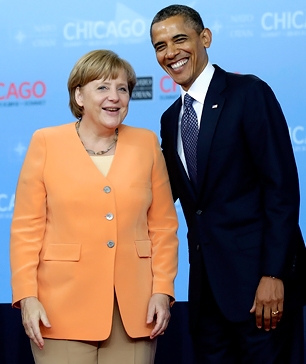
President Obama greets German Chancellor Angela Merkel. Photo: John Gress, Getty Images
The common denomination of the political establishment at the present moment, both Republican and Democratic parties, is the idea of austerity, that is, of giving the working class less. Less wages and less benefits. Less health care, less education, less housing. And fewer rights. The Republican Party has adopted a harsh rhetoric aimed at breaking the power of the unions; the Democratic Party, which depends on unions as the principal pillar of its popular support, would not see the unions broken, but also subscribes to the idea that the unions must accept less.
The attack on women and immigrants is somewhat different. While the Republicans have launched an attack on women and their rights, Obama and the Democrats by and large continue to defend women’s rights. But they do so ineffectively. MoveOn.org and other liberal think-tanks have named this the “War on Women” and look to the Democrats to win the war. Yet the Democratic Party fails to discipline its Blue Dogs, social conservatives who have joined the attack on women. While Obama and the Democrats support women’s right to choose (abortion rights), they do less well in the fight to defend working women. The bi-partisan attack on public sector workers (Obama set the trend by freezing Federal workers’ wages) has fallen hardest on women and African Americans. And Obama’s record in enforcing working women’s fight for fair wages has not been great. As with other social movements, the tendency of women’s organizations to rely on the Democrats weakens their ability to mobilize independently and create the social force needed to really defend women.
Similarly with the immigrant movement: while the Republicans have waged war on immigrants, the Democrats have failed to mount an adequate defense. While Obama promised in his 2008 campaign to fight for immigration reform, nothing happened during either the first two years when the Democrats had a majority and less than nothing since then—until the election period, when under pressure from the DREAMer movement, Obama extended prosecutorial discretion. While there are differences, not only difference in rhetoric but real differences in position between the Republicans and the Democrats on issues of women and immigrants, the Democratic Party has done little to effectively defend and advance the cause of either. The most important point to be made here is that the austerity program shared by both Republicans and Democrats will have a disastrous impact on the lives of most Americans, and will fall especially heavily on women, African Americans and Latinos.
Nobel Prize winner and New York Times columnist Paul Krugman has advocated government action in the form of great economic stimulus. He and others have called for the government to engage in deficit spending to finance rebuilding the national infrastructure and improvements in health and education in order to provide jobs and incomes which in turn would lead to a revival of the economy. While we do not believe that such measures can solve capitalism’s crisis in the long run, we do support a government program to create jobs which should be financed by taxing corporations and the wealthy. At the same time, we should raise the demand to nationalize the banks and other financial institutions, arguing that the bankers who created the crisis and continue to profit off of it, should not be permitted to continue to exploit the American people.
Ongoing Social Protest
While the general political situation is quite adverse to the working class, the unions and the left, we continue to see large scale social protest throughout the United States principally around issues of economic inequality, racial injustice, and environmental degradation. Although the decline of the Occupy movement tends to condition our outlook, if we look back over the decade we see a period of tremendous protests by Latino immigrants in 2006 and by the Wisconsin capitol protestors and by Occupy Wall Street and its offspring in 2011. We should understand from these experiences that the underlying inequalities in American society and the privations and suffering caused by the crisis mean that new, massive social protest is both possibly and likely in the short term, that is, within the next few years. We know from history and from our own experiences since the 1960s and since that when new social movements arise they have a dramatic impact on the participants and observers, often leading to rapid changes in political consciousness, to organization, and to greater militancy.
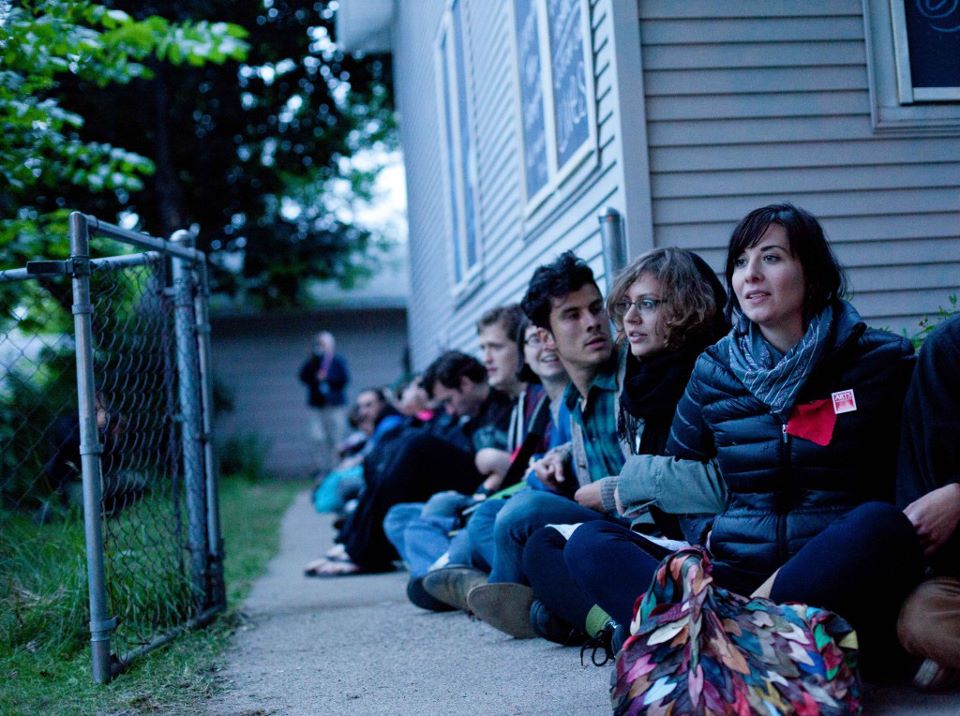
Occupy activists defend a home from foreclosure in Minnesota.
The Occupy movement, for example, put issues of economic inequality, corporate power, and the role of money in politics on the American agenda, raising class consciousness as almost no movement in the post-war period had. While the Occupy movement appears to be in decline, it is also true that throughout the country, the remaining Occupy groups and their various action committees in both large and small cities continue to carry out protests against all sorts of corporate and political targets involving thousands of participants.
Even if Occupy’s momentum has been broken, other movements continue to arise, some of them quite large and important. The silent march organized by the NAACP, SEIU and many local groups, and largely made up of African Americans and Latinos, which paraded through New York City on June 17, demanded an end to the “stop-and-frisk” policies that unfairly discriminate against African American and Latino men, causing humiliation for them and their communities. This march followed many demonstrations in cities around the country just a few months earlier to protest the murder of Trayvon Martin, to demand the arrest and indictment of his killer, and to call for an end to the “stand-your-ground” laws. We can expect to see other such protests against racial injustice.
Similarly, the mostly Latino immigrant youth movement often referred to as the “DREAMers” took advantage of Obama’s political vulnerability during the election campaign period to occupy his campaign offices around the country and demanding relief for immigrant youth. Under their pressure, Obama made an announcement that ICE should stop the deportation of up to 800,000 young immigrants for two years. While a shrewd political move by Obama, it is also a victory for an important contingent of the immigrant rights movement. We can expect there to be continued struggles by immigrants as long as there is no current legislation proposed for sweeping immigration reform.
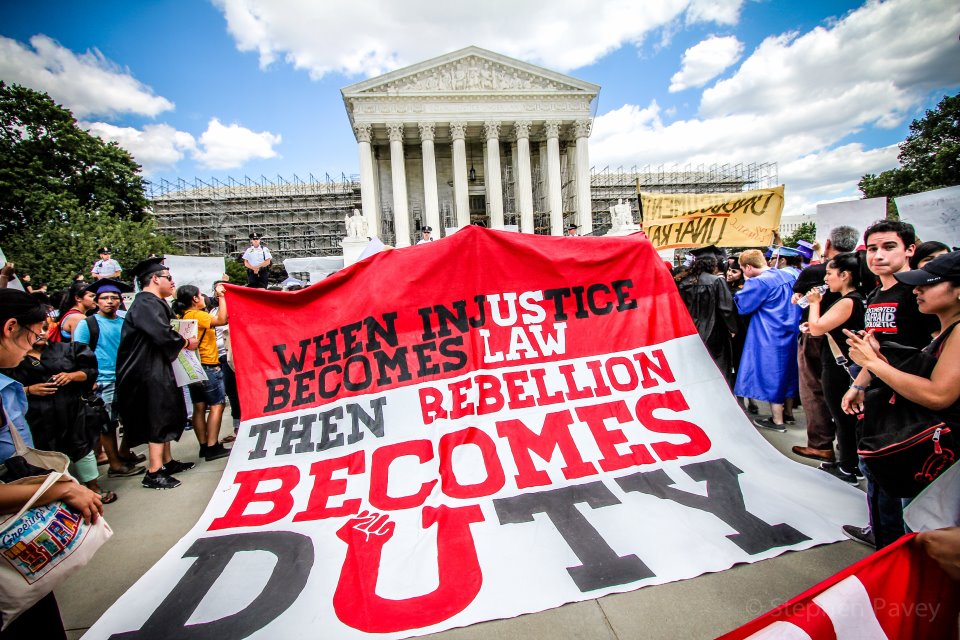
The National Immigrant Youth Alliance hosts a “graduation of resistance.” Photo: Steve Pavey
Environmental organizations continue to produce militant activists who are engaged in activities throughout the country. Activists also continue to organize large scale protests around the environment, such as the recent occupation of the Ohio statehouse by 1,000 environmentalists against the expansion of fracking.
The Weakness of Labor Struggle
Writing this survey of the balance of forces in the middle of 2012, we are aware that the weakest link here is what remains of the labor movement. U.S. labor unions, continuing under the control at their highest levels of a bureaucratic caste of officials, continue to rely on the Democratic Party. Most American workers have little or no direct class-struggle experience, most have never attended a union meeting, never participated in a strike, and while some appreciate the economic advantages of unionization, many others pay dues only because it is a condition of employment. The depth and length of the recession has made even workers reluctant to struggle for fear of losing their jobs and incomes. Nevertheless, rank-and-file workers will have to be organized, within and without the unions, through existing unions, workers centers, or other forms of organization if we are to bring about any serious change in American society.
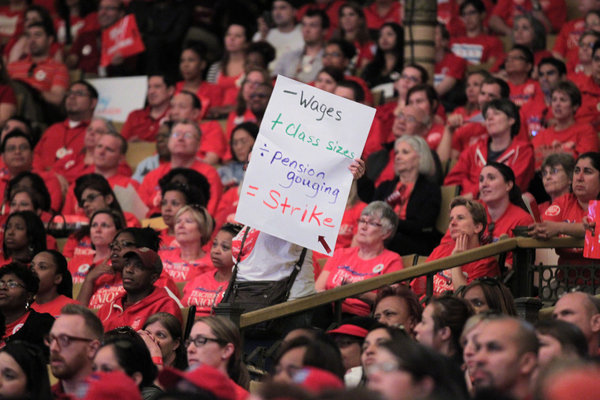
Chicago teachers do the math–the answer is “strike!”
The Chicago Teacher Union’s vote to strike, perhaps as early as September, represents what may be the next big test for American labor. If the CTU strikes and proves successful in defending teachers from further depredations, it could have an enormous impact on other teachers unions, on public employees, and on the labor movement in general. Socialists should be involved in organizing support for the Chicago teachers both as a way of have a small impact on their struggle, but equally important for us, as a way of reorienting toward working class work. At the same time, it provides an opportunity for a national campaign which can involve socialist activists as teachers, parents, and students.
Dan La Botz is a Cincinnati-based teacher, writer and activist. He is a member of Solidarity’s National Committee.
